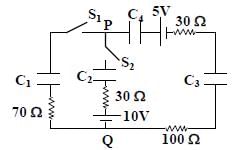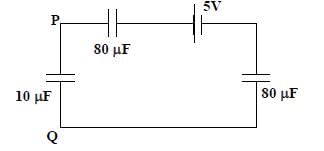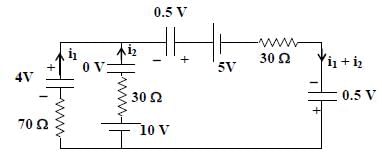JEE Exam > JEE Questions > In the circuit shown, initially there is no c...
Start Learning for Free
In the circuit shown, initially there is no charge on capacitors and keys S1 and S2 are open. The values of the capacitors are 
 Which of the statement(s) is/are correct?
Which of the statement(s) is/are correct?


 Which of the statement(s) is/are correct?
Which of the statement(s) is/are correct?
- a)The key S1 is kept closed for long time such that capacitors are fully charged. Now key S2 is closed, at this time, the instantaneous current across 30Ω resistor (between points P and Q) will be 0.2 A (round off to 1st decimal place).
- b)If key S1 is kept closed for long time such that capacitors are fully charged, the voltage across the
capacitor C1 will be 4V. - c)At time t = 0, the key S1 is closed, the instantaneous current in the closed circuit will be 25 mA
- d)If key S1 is kept closed for long time such that capacitors are fully charged, the voltage difference between points P and Q will be 10 V.
Correct answer is option 'B,C'. Can you explain this answer?
Verified Answer
In the circuit shown, initially there is no charge on capacitors and k...
S1 closed for long time









|
Explore Courses for JEE exam
|

|
Similar JEE Doubts
In the circuit shown, initially there is no charge on capacitors and keys S1 and S2 are open. The values of the capacitors are Which of the statement(s) is/are correct?a)The key S1 is kept closed for long time such that capacitors are fully charged. Now key S2 is closed, at this time, the instantaneous current across 30Ω resistor (between points P and Q) will be 0.2 A (round off to 1st decimal place).b)If key S1 is kept closed for long time such that capacitors are fully charged, the voltage across thecapacitor C1 will be 4V.c)At time t = 0, the key S1 is closed, the instantaneous current in the closed circuit will be 25 mAd)If key S1 is kept closed for long time such that capacitors are fully charged, the voltage difference between points P and Q will be 10 V.Correct answer is option 'B,C'. Can you explain this answer?
Question Description
In the circuit shown, initially there is no charge on capacitors and keys S1 and S2 are open. The values of the capacitors are Which of the statement(s) is/are correct?a)The key S1 is kept closed for long time such that capacitors are fully charged. Now key S2 is closed, at this time, the instantaneous current across 30Ω resistor (between points P and Q) will be 0.2 A (round off to 1st decimal place).b)If key S1 is kept closed for long time such that capacitors are fully charged, the voltage across thecapacitor C1 will be 4V.c)At time t = 0, the key S1 is closed, the instantaneous current in the closed circuit will be 25 mAd)If key S1 is kept closed for long time such that capacitors are fully charged, the voltage difference between points P and Q will be 10 V.Correct answer is option 'B,C'. Can you explain this answer? for JEE 2025 is part of JEE preparation. The Question and answers have been prepared according to the JEE exam syllabus. Information about In the circuit shown, initially there is no charge on capacitors and keys S1 and S2 are open. The values of the capacitors are Which of the statement(s) is/are correct?a)The key S1 is kept closed for long time such that capacitors are fully charged. Now key S2 is closed, at this time, the instantaneous current across 30Ω resistor (between points P and Q) will be 0.2 A (round off to 1st decimal place).b)If key S1 is kept closed for long time such that capacitors are fully charged, the voltage across thecapacitor C1 will be 4V.c)At time t = 0, the key S1 is closed, the instantaneous current in the closed circuit will be 25 mAd)If key S1 is kept closed for long time such that capacitors are fully charged, the voltage difference between points P and Q will be 10 V.Correct answer is option 'B,C'. Can you explain this answer? covers all topics & solutions for JEE 2025 Exam. Find important definitions, questions, meanings, examples, exercises and tests below for In the circuit shown, initially there is no charge on capacitors and keys S1 and S2 are open. The values of the capacitors are Which of the statement(s) is/are correct?a)The key S1 is kept closed for long time such that capacitors are fully charged. Now key S2 is closed, at this time, the instantaneous current across 30Ω resistor (between points P and Q) will be 0.2 A (round off to 1st decimal place).b)If key S1 is kept closed for long time such that capacitors are fully charged, the voltage across thecapacitor C1 will be 4V.c)At time t = 0, the key S1 is closed, the instantaneous current in the closed circuit will be 25 mAd)If key S1 is kept closed for long time such that capacitors are fully charged, the voltage difference between points P and Q will be 10 V.Correct answer is option 'B,C'. Can you explain this answer?.
In the circuit shown, initially there is no charge on capacitors and keys S1 and S2 are open. The values of the capacitors are Which of the statement(s) is/are correct?a)The key S1 is kept closed for long time such that capacitors are fully charged. Now key S2 is closed, at this time, the instantaneous current across 30Ω resistor (between points P and Q) will be 0.2 A (round off to 1st decimal place).b)If key S1 is kept closed for long time such that capacitors are fully charged, the voltage across thecapacitor C1 will be 4V.c)At time t = 0, the key S1 is closed, the instantaneous current in the closed circuit will be 25 mAd)If key S1 is kept closed for long time such that capacitors are fully charged, the voltage difference between points P and Q will be 10 V.Correct answer is option 'B,C'. Can you explain this answer? for JEE 2025 is part of JEE preparation. The Question and answers have been prepared according to the JEE exam syllabus. Information about In the circuit shown, initially there is no charge on capacitors and keys S1 and S2 are open. The values of the capacitors are Which of the statement(s) is/are correct?a)The key S1 is kept closed for long time such that capacitors are fully charged. Now key S2 is closed, at this time, the instantaneous current across 30Ω resistor (between points P and Q) will be 0.2 A (round off to 1st decimal place).b)If key S1 is kept closed for long time such that capacitors are fully charged, the voltage across thecapacitor C1 will be 4V.c)At time t = 0, the key S1 is closed, the instantaneous current in the closed circuit will be 25 mAd)If key S1 is kept closed for long time such that capacitors are fully charged, the voltage difference between points P and Q will be 10 V.Correct answer is option 'B,C'. Can you explain this answer? covers all topics & solutions for JEE 2025 Exam. Find important definitions, questions, meanings, examples, exercises and tests below for In the circuit shown, initially there is no charge on capacitors and keys S1 and S2 are open. The values of the capacitors are Which of the statement(s) is/are correct?a)The key S1 is kept closed for long time such that capacitors are fully charged. Now key S2 is closed, at this time, the instantaneous current across 30Ω resistor (between points P and Q) will be 0.2 A (round off to 1st decimal place).b)If key S1 is kept closed for long time such that capacitors are fully charged, the voltage across thecapacitor C1 will be 4V.c)At time t = 0, the key S1 is closed, the instantaneous current in the closed circuit will be 25 mAd)If key S1 is kept closed for long time such that capacitors are fully charged, the voltage difference between points P and Q will be 10 V.Correct answer is option 'B,C'. Can you explain this answer?.
Solutions for In the circuit shown, initially there is no charge on capacitors and keys S1 and S2 are open. The values of the capacitors are Which of the statement(s) is/are correct?a)The key S1 is kept closed for long time such that capacitors are fully charged. Now key S2 is closed, at this time, the instantaneous current across 30Ω resistor (between points P and Q) will be 0.2 A (round off to 1st decimal place).b)If key S1 is kept closed for long time such that capacitors are fully charged, the voltage across thecapacitor C1 will be 4V.c)At time t = 0, the key S1 is closed, the instantaneous current in the closed circuit will be 25 mAd)If key S1 is kept closed for long time such that capacitors are fully charged, the voltage difference between points P and Q will be 10 V.Correct answer is option 'B,C'. Can you explain this answer? in English & in Hindi are available as part of our courses for JEE.
Download more important topics, notes, lectures and mock test series for JEE Exam by signing up for free.
Here you can find the meaning of In the circuit shown, initially there is no charge on capacitors and keys S1 and S2 are open. The values of the capacitors are Which of the statement(s) is/are correct?a)The key S1 is kept closed for long time such that capacitors are fully charged. Now key S2 is closed, at this time, the instantaneous current across 30Ω resistor (between points P and Q) will be 0.2 A (round off to 1st decimal place).b)If key S1 is kept closed for long time such that capacitors are fully charged, the voltage across thecapacitor C1 will be 4V.c)At time t = 0, the key S1 is closed, the instantaneous current in the closed circuit will be 25 mAd)If key S1 is kept closed for long time such that capacitors are fully charged, the voltage difference between points P and Q will be 10 V.Correct answer is option 'B,C'. Can you explain this answer? defined & explained in the simplest way possible. Besides giving the explanation of
In the circuit shown, initially there is no charge on capacitors and keys S1 and S2 are open. The values of the capacitors are Which of the statement(s) is/are correct?a)The key S1 is kept closed for long time such that capacitors are fully charged. Now key S2 is closed, at this time, the instantaneous current across 30Ω resistor (between points P and Q) will be 0.2 A (round off to 1st decimal place).b)If key S1 is kept closed for long time such that capacitors are fully charged, the voltage across thecapacitor C1 will be 4V.c)At time t = 0, the key S1 is closed, the instantaneous current in the closed circuit will be 25 mAd)If key S1 is kept closed for long time such that capacitors are fully charged, the voltage difference between points P and Q will be 10 V.Correct answer is option 'B,C'. Can you explain this answer?, a detailed solution for In the circuit shown, initially there is no charge on capacitors and keys S1 and S2 are open. The values of the capacitors are Which of the statement(s) is/are correct?a)The key S1 is kept closed for long time such that capacitors are fully charged. Now key S2 is closed, at this time, the instantaneous current across 30Ω resistor (between points P and Q) will be 0.2 A (round off to 1st decimal place).b)If key S1 is kept closed for long time such that capacitors are fully charged, the voltage across thecapacitor C1 will be 4V.c)At time t = 0, the key S1 is closed, the instantaneous current in the closed circuit will be 25 mAd)If key S1 is kept closed for long time such that capacitors are fully charged, the voltage difference between points P and Q will be 10 V.Correct answer is option 'B,C'. Can you explain this answer? has been provided alongside types of In the circuit shown, initially there is no charge on capacitors and keys S1 and S2 are open. The values of the capacitors are Which of the statement(s) is/are correct?a)The key S1 is kept closed for long time such that capacitors are fully charged. Now key S2 is closed, at this time, the instantaneous current across 30Ω resistor (between points P and Q) will be 0.2 A (round off to 1st decimal place).b)If key S1 is kept closed for long time such that capacitors are fully charged, the voltage across thecapacitor C1 will be 4V.c)At time t = 0, the key S1 is closed, the instantaneous current in the closed circuit will be 25 mAd)If key S1 is kept closed for long time such that capacitors are fully charged, the voltage difference between points P and Q will be 10 V.Correct answer is option 'B,C'. Can you explain this answer? theory, EduRev gives you an
ample number of questions to practice In the circuit shown, initially there is no charge on capacitors and keys S1 and S2 are open. The values of the capacitors are Which of the statement(s) is/are correct?a)The key S1 is kept closed for long time such that capacitors are fully charged. Now key S2 is closed, at this time, the instantaneous current across 30Ω resistor (between points P and Q) will be 0.2 A (round off to 1st decimal place).b)If key S1 is kept closed for long time such that capacitors are fully charged, the voltage across thecapacitor C1 will be 4V.c)At time t = 0, the key S1 is closed, the instantaneous current in the closed circuit will be 25 mAd)If key S1 is kept closed for long time such that capacitors are fully charged, the voltage difference between points P and Q will be 10 V.Correct answer is option 'B,C'. Can you explain this answer? tests, examples and also practice JEE tests.

|
Explore Courses for JEE exam
|

|
Signup for Free!
Signup to see your scores go up within 7 days! Learn & Practice with 1000+ FREE Notes, Videos & Tests.
























